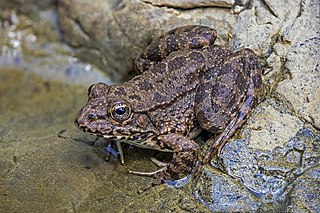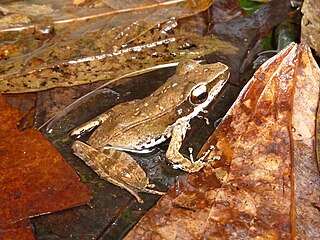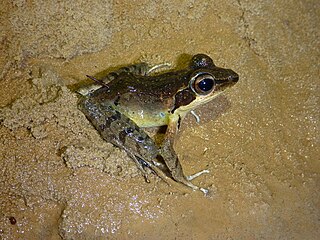
True frogs is the common name for the frog family Ranidae. They have the widest distribution of any frog family. They are abundant throughout most of the world, occurring on all continents except Antarctica. The true frogs are present in North America, northern South America, Europe, Africa, and Asia. The Asian range extends across the East Indies to New Guinea and a single species, the Australian wood frog, has spread into the far north of Australia.

Indosylvirana aurantiaca, commonly known as the golden frog, is a species of frog endemic to the Western Ghats of India. The species is also known as the Trivandrum frog, the common wood frog, or the small wood frog.

The common green frog is a frog species of in the true frog family Ranidae; some sources still use the old name Rana erythraea. It lives in Southeast Asia and is also known as green paddy frog, red-eared frog or leaf frog. The last name, however, commonly refers to the Neotropical tree frogs which make up the subfamily Phyllomedusinae. These are not closely related to H. erythraea, belonging to family Hylidae instead.

Hylarana garoensis, commonly known as Boulenger's Garo hill frog, is a species of frog in the family Ranidae. Its natural habitats are subtropical or tropical moist lowland forests, subtropical or tropical moist shrubland, subtropical or tropical high-altitude grassland, and rivers; it is found in India and possibly Bangladesh. It is threatened by habitat loss.

Hylarana latouchii, also known as Kuatun frog, La Touche's frog, or broad-folded frog, is a species of frog in the family Ranidae. It was formerly placed in genus Rana. The specific name honours the collector of the type series: "Hylarana" latouchii was described by George Albert Boulenger based on three specimens collected by Irish ornithologist John D. La Touche in Guadun village in Wuyishan, Fujian, China.

Hylarana tytleri is a frog species in the family Ranidae. It is found in eastern and northeastern India, Bangladesh, and southern Nepal, and possibly at lower elevations in Bhutan. It was formerly placed in Rana, and included in the common green frog. It is probably a close relative of that species nonetheless, and thus placed in the revalidated genus Hylarana, of which H. erythraea is the type species. Common name Theobald's ranid frog has been coined for it, although common names for Indian frogs previously identified as Rana erythraea include yellow-striped frog, leaf frog, and leaping frog.

Pulchrana baramica, the Baram River frog, brown marsh frog, or masked rough-sided frog, is a species of "true frog", family Ranidae. It is found in the Malay Peninsula, including the extreme south Thailand, Peninsular Malaysia, and Singapore, and in the Malay Archipelago, including Borneo, and the Indonesian islands Java, Sumatra, and Bangka Island. Its type locality is the Baram River in Sarawak, Malaysia, giving it one of its common names. Its natural habitats are tropical moist lowland forests and swamps. It is not considered threatened by the IUCN.

Hylarana macrodactyla is a species of frog in the family Ranidae. It is also known as the Guangdong frog, three-striped grass frog and the marbled slender frog.

Abavorana luctuosa, also known as the Malaysian frog, mahogany frog or purple frog, is a species of true frog. It is found in the Malay Peninsula and in Borneo. It was formerly placed in the genus Hylarana.

Hydrophylax gracilis, also known as Gravenhorst's frog, Gravenhorst's golden-backed frog, and Sri Lanka wood frog, is a species of frog in the family Ranidae. It is endemic to Sri Lanka.

Hylarana, commonly known as golden-backed frogs, is a genus of true frogs found in tropical Asia. It was formerly considered highly diverse, containing around 84 to 96 valid species, but taxonomic revision resulted in a major change in the contents of the genus, and today it is recognised as containing just four species.

Papurana celebensis, also known as the Celebes frog, is a species of true frog in the family Ranidae. Prior to being reclassified into the genus Papurana in 2020, it was referred to as "Hylarana" celebensis. It is endemic to Sulawesi (Celebes), Indonesia. It is a lowland forest species, also occurring disturbed habitats.

Papurana elberti is a species of true frog. It is native to Indonesia and Timor-Leste and found on the islands of Timor and Wetar. The specific name elberti honours Johannes Elbert, a German naturalist who joined an expedition to the Lesser Sunda Islands and Sulawesi in 1910. Common name Lesser Sundas frog has been coined for it.

Hylarana taipehensis is a species of "true frog", family Ranidae. It has several common names, including Taipei frog, Taipei grass frog, two-striped grass frog, or striped slender frog. Following its redelimitation in 2019, its range is now believed to extend from Taiwan and southern China to Vietnam, Laos, Cambodia, and eastern Thailand.

Hylarana glandulosa, commonly known as the rough-sided frog or the glandular frog, is a species of true frog in the genus Hylarana. It is native to Brunei Darussalam, Indonesia, Malaysia, Singapore, Thailand, and Vietnam. Its natural habitats are subtropical or tropical moist lowland forest, subtropical or tropical swampland, rivers, freshwater marshes, caves, and plantations. It is not considered threatened by the IUCN.

Hylarana leptoglossa, commonly known as the long-tongued frog, is a species of true frog in the genus Hylarana. It is native to Bangladesh, northeastern India, Myanmar, and western Thailand. It is also known under the common names Cope's frog, Cope's Assam frog, palebrown small frog, and Assam forest frog. It has recently been reported also from Bhutan.
Hylarana margariana, commonly known as the Irrawaddy frog, is a species of true frog in the family Ranidae. It is native to Myanmar and may be present in China.
Hylarana montivaga, sometimes known as Langbian Plateau frog or Chantaburi stream frog, is a species of "true frog" in the family Ranidae. Its generic placement is currently unsettled. It is known from the Langbian Plateau in southern-central Vietnam; records from elsewhere refer to other species.
Hylarana spinulosa, also known as fine-spined frog and spiny frog, is a species of true frog, family Ranidae. It is endemic to Hainan, southern China. It occurs in tropical forests at elevations of 80–840 m (260–2,760 ft) above sea level. Breeding takes place in pools and slow-flowing streams.
















